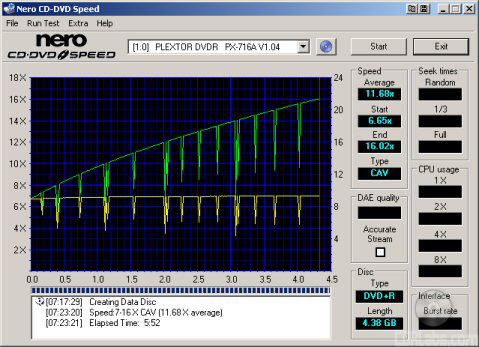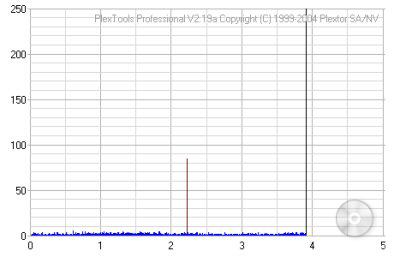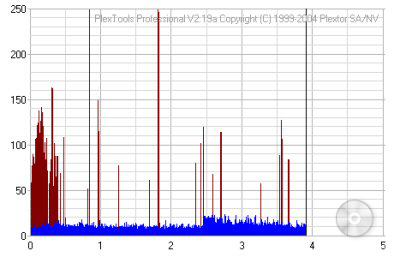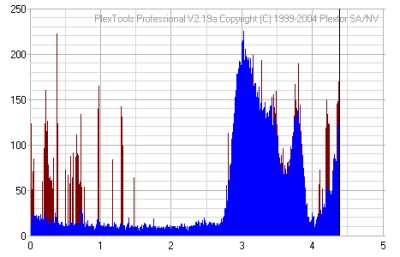DVD Write and ReWrite Tests - Nero Burning Rom 6.6.0.6 and DLA 4.60:
To test the DVD writing performance of the PX-716A I used Verbatim 16x DVD+R, Taiyo Yuden 8x DVD-R, Verbatim 4x DVD-RW and Verbatim 8x DVD+RW media. I created about 4GB of random files and directories on my hard drive and then burned them to our test discs with Nero. All tests have been run with AutoStrategy and PoweRec enabled.
When writing to DVD+R and DVD-R media at 16x, the PX-716A uses CAV. By looking at the screenshots above, you can see that Plextor's new drive starts writing at about 6x and accelerates, reaching its maximum speed as it reaches the end of the disc.
The PX-716A is also one of the first drives to feature 8x DVD+RW writing speeds. To reach this speed, it uses P-CAV, or Partial CAV. The drive starts writing at 6x and accelerates, reaching 8x at about the 0.7GB mark.
| Plextor PX-716A |
Sony DRU-710A |
Pioneer DVR-A08XL |
NEC ND-3500A |
|
| DVD+R | 5:32 | 5:44 | 6:41 | 5:38 |
| DVD-R | 5:53 | 6:54 | 6:21 | 5:32 |
| DVD+RW | 6:48 | 12:33 | 12:55 | 12:33 |
| DVD-RW | 13:50 | 13:17 | 13:52 | 13:11 |
When writing to DVD+R media at 16x, the PX-716A is one of the faster drives we've tested. It was about 6 seconds faster than the drive from NEC and a good minute faster than the Pioneer DVR-A08XL. Thanks to its 8x writing speed, Plextor's new DVD writer also had the fastest DVD+RW writing time we've seen, beating the other drives by a sizable margin. Unfortunately, the PX-716A didn't do as well when writing to DVD-R media. Due to slow downs caused by PoweRec, it never really reached 16x, causing it to be about 20 seconds slower than the ND-3500A.
While Plextor has a good sized list of compatible media on their website, I wanted to see for myself how well the PX-716A worked with some of the DVD+R and DVD-R media currently available.
| Manufacturer ID | Max Write Speed |
Average Write Time |
|
| Memorex 8x DVD+R | CMC MAG E01 | 8x | 7:22 |
| RiDATA 8x DVD+R | RITEKR03 | 8x* | 9:21 |
| Taiyo Yuden 8x DVD+R | YUDEN000T02 | 16x* | 5:42 |
| Verbatim 8x DVD+R | MCC-003 | 12x* | 6:44 |
| Memorex 16x DVD+R | CMC MAG M01 | 8x | 7:26 |
| Optodisc 16x DVD+R | OPTODISCR16 | 16x | 5:33 |
| RiDATA 16x DVD+R | RITEKR04 | 16x* | 6:41 |
| Sony 16x DVD+R | SONYD21 | 16x* | 7:27 |
| Verbatim 16x DVD+R | MCC-004 | 16x | 5:32 |
| Fuji 8x DVD-R | FUJIFILM03 | 8x | 7:45 |
| Maxell 8x DVD-R | MXL RG03 | 8x | 7:38 |
| Memorex 8x DVD-R | CMC MAG.AE1 | 8x | 7:40 |
| Optodisc 8x DVD-R | OPTODISCR008 | 8x | 7:41 |
| RiDATA 8x DVD-R | RITEKG05 | 8x | 7:44 |
| Sony 8x DVD-R | SONY08D1 | 8x* | 10:24 |
| Taiyo Yuden 8x DVD-R | TYG02 | 16x* | 5:53 |
| Verbatim 8x DVD-R | MCC 02RG20 | 8x | 7:38 |
| Verbatim 16x DVD-R | MCC 03RG20 | 16x* | 6:06 |
The PX-716A's media compatibility was a mixed bag. While the drive wrote to a good portion of our DVD+R test media at 16x, only two types of DVD-R disc worked at this speed. The drive wasn't able to write at this speed all of the time either. In a number of cases, Plextor's PoweRec technology kept the drive from reaching the maximum available writing speed.
So what about writing quality? Testing a drive's DVD writing quality isn't easy. Until now, there were very few options, unless you wanted to shell out thousands of dollars for a certified test machine. Fortunately, we can test a disc's PI (Parity Inner) and PO (Parity Outer) rates using the PI/PO tests built into PlexTools Professional. For this review, we're going to use the Burst test run at 2x using "Middle Accuracy". This willgive us the number of PI Errors (before correction), PO Errors and the number of uncorrectable blocks (POF). I also tested the discs with KProbe2. As you'll see, the results are sometimes different than those of PlexTools.
So what are "good" results supposed to look like? Unfortunately, Plextor doesn't really say. However, it's generally accepted that with an ECC sum of 8, the number of PI errors should not exceed 280. Since POF errors are uncorrectable, we really don't want to see any at all.
|
|
|
||||||||||||||||||||||||||||||||||||||||||||||||||||||||||||||||||||||||
|
|
|
||||||||||||||||||||||||||||||||||||||||||||||||||||||||||||||||||||||||
|
|
|
||||||||||||||||||||||||||||||||||||||||||||||||||||||||||||||||||||||||
With earlier firmware versions, I was less than impressed with the PX-716A's writing quality. While the drive yielded good results at slower speeds, the PIE errors were pretty high on discs recorded at 16x. As you can see, that wasn't the case with the 1.04 firmware. While the number of PIE errors varied from one manufacturer to another, they remained well within acceptable limits. More importantly, there were no POF errors on any of the discs I tested.
|
|
|
||||||||||||||||||||||||||||||||||||||||||||||||||||||||||||||||||||||||
|
|
|
||||||||||||||||||||||||||||||||||||||||||||||||||||||||||||||||||||||||
|
|
|
||||||||||||||||||||||||||||||||||||||||||||||||||||||||||||||||||||||||
The PX-716A's writing quality was pretty good with most of the DVD-R media we tested. The only exception being the 8x DVD-R media from Memorex. As you can see, the number of PIF errors was pretty high across the entire disc.
So what about AutoStrategy? Is it nothing more than a marketing gimmick or does it really work? To find out, I first had to locate some media that worked with this new technology. This was easier said than done considering how quickly Plextor adds support for new media. Digging through the stacks of media in the 'Labs, I finally found a few discs that were, according to Plextor, supported by AutoStrategy.
First up, I tried some of Optodisc's 4x DVD+R (OPTODISC OR4) media. For a baseline, I wrote a disc with AutoStrategy off. With it off, the drive uses a default writing strategy. Next, I wrote a disc with AutoStrategy on. As you can see, it took about 2:25 to develop a writing strategy for the media. After this, I burned another disc with AutoStrategy on. With a writing strategy already created, the writing process was much faster. However, it was still about 10 seconds slower than with AutoStrategy off.
|
|
|
||||||||||||||||||||||||||||||||||||||||||||||||||||||||||||
Comparing the first two results, you can see that the writing quality is slightly better with AutoStrategy on. This writing strategy also seemed to work on the third disc as the average number of PI and PO errors was very similar. Next we'll bump the writing speed up to 8x by using some of BenQ's 8x DVD-R (DAXON AZ2) media.
|
|
|
||||||||||||||||||||||||||||||||||||||||||||||||||||||||||||
Unfortunately, AutoStrategy didn't work quite as well with this media. It not only took longer to develop a writing strategy, the results were less than impressive. Even after repeated burns, the number of PI and PO errors remained relatively high.
| Plextor PX-716A |
Sony DRU-710A |
Pioneer DVR-A08XL |
NEC ND-3500A |
|
| DVD+RW Quick | 32 seconds | 14 seconds | 29 seconds | 28 seconds |
| DVD+RW Full | 7:46 | 14:31 | 15:22 | 14:45 |
| DVD-RW Quick | 1:03 | 53 seconds | 57 seconds | 56 seconds |
| DVD-RW Full | 15:09 | 14:46 | 15:09 | 14:41 |
To test the PX-716A's packet writing performance I used DLA 4.60. Verbatim 8x DVD+RW and 4x DVD-RW media were used once again.
| Plextor PX-716A |
Sony DRU-710A |
Pioneer DVR-A08XL |
NEC ND-3500A |
|
| DVD+RW Write | 6:33 | 12:30 | 14:36 | 12:14 |
| DVD+RW Read | 5:47 | 16:43 | 13:06 | 10:19 |
| DVD-RW Write | 12:44 | 12:22 | 14:47 | 12:14 |
| DVD-RW Read | 6:05 | 14:33 | 13:33 | 10:42 |
Like Plextor's previous DVD writers, the PX-716A had some trouble with DLA. While the drive performed flawlessly with DVD+RW discs, it took longer than it should have to write our test data to Verbatim's 4x DVD-RW media. To get around this problem, I used the bundled packet writing software, Roxio's Drag-to-Disc.
Software issues aside, Plextor's new drive performed pretty well in our packet writing tests. While not as fast as some of the other drives when writing to DVD-RW media, its 8x DVD+RW writing speed gave it a definite advantage. Thanks to 12x DVD±RW read speeds, the PX-716A also took about 6 minutes to read back all 4GB of files and directories.
DVD+R DL Write Tests - Nero Burning Rom 6.6.0.6:
To test the double layer DVD writing performance of the PX-716A, I used DVD+R DL media from both RiDATA and Verbatim. I created about 8GB of random files and directories on my hard drive and then burned them to our test discs with Nero.
Out of the box, the PX-716A has a maximum DVD+R DL writing speed of 4x. With the 1.04 firmware, this speed is increased to 6x. Using CD Speed we can see that aside from the slight dip at the layer change, the drive writes at this speed from start to finish.
While Plextor's new drive had no problems writing to Verbatim's DVD+R DL media at 6x, RiDATA's discs would not work at anything faster than 4x. This is still pretty good though, considering most drives write to Ritek manufactured media at only 2.4x.
| DVD+R DL Write | Plextor PX-716A |
Sony DRU-710A |
Pioneer DVR-A08XL |
NEC ND-3500A |
| 2.4x | 43:42 | 43:10 | 43:33 | 42:37 |
| 4x | 26:47 | 26:37 | 26:34 | 26:26 |
| 6x | 18:17 | n/a | n/a | n/a |
The PX-716A had no problems taking the top spot in this test. Thanks to its 6x DVD+R DL writing speed, it took the drive only 18:17 to write 8001MB of data. If you do the math, this is a good 8 minutes faster than the drives from the competition. So what about writing quality? Take a look below.
|
|
||||||||||||||||||||||||||||||||||||||||||||||||||||||||
While Verbatim's discs are rated at only 2.4x, it's obvious they can handle much more. Even at 6x, the writing quality was quite good. Aside from the small spike at the layer change, the number of PI errors was very low from start to finish.The RiDATA discs didn't work quite as well. Looking at the results above, you can see that the PI errors were considerably higher. This didn't seem to have any effect on readability though, at least with the PX-716A.
Verbatim recently sent us a few samples of their new 4x DVD-R DL media. As one of the few drives to support this new media, I figured it would be worth going back and running a few tests with the PX-716A. While originally tested with firmware versions 1.03 and 1.04, our drive has been upgraded to version 1.06. This new firmware gives the PX-716A the ability to write to DVD-R DL at 6x.
Using DVDINFOpro, we can see that the discs have a manufacturer ID of "MKM 01RD30" and will work at speeds as high as 6x. This is pretty impressive considering they're rated at only 4x.
The PX-716A had no problems writing to Verbatim's new DVD-R DL media at 6x. Using CD Speed we can see that aside from the dip at the layer change, the drive writes at this speed from start to finish.
| DVD-R DL Write | Plextor PX-716A |
Pioneer DVR-A09XL |
| 6x | 19:01 | 22:42 |
The PX-716A did pretty well here. While not as fast as when writing to DVD+R DL discs at 6x, it was a good 2:40 faster than the Pioneer DVR-A09XL. So what about writing quality? Take a look below.
|
||||||||||||||||||||||||||||
Testing went smoothly with PlexTools Professional XL. Looking at the graph above, you can see that the PI errors remained fairly low throughout the entire disc. Unfortunately, the Lite-On SOHW-1633S that I normally use with KProbe had some problems reading the disc. Instead of testing at 4x, the drive's actual read speed was closer to 2x. Nevertheless, it was able to complete the test.
Performance Revisited:
While the PX-716A still has a few rough spots, it performed pretty well overall. The drive flew through our DVD writing tests, turning in some impressive times with DVD±R, DVD±RW and DVD+R DL media. Plextor's new drive was also very fast when reading DVD's. In our tests, the PX-716A was able to read single layer data and video DVD's at 16x and most recordable media at 12x.
Plextor's new DVD writer also did very well in our CD read tests. With SpeedRead enabled, it was able to read pressed and CD-R media at speeds as high as 48x and had some very good seek times. The PX-716A also did very well in our DAE tests, reaching a maximum speed of 41x. Writing CD's wasn't a problem for the PX-716A either. The drive turned in some good writing times and its writing quality was quite good. With all things considered, the Plextor PX-716A gets a 9 out of 10 for the performance section of this review.




































